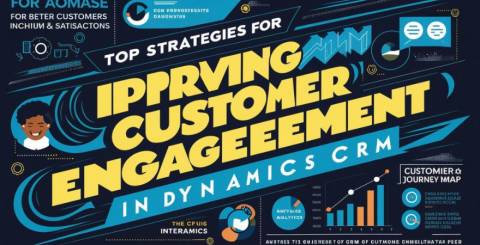Top Strategies for Improving Customer Engagement in Dynamics CRM

Overview
It's one of the keystones, basic but key in the successful highly competitive modern business environment, where the connection with the customer is a must. Dynamics CRM (Customer Relationship Management) works in the capacity of a powerful tool that allows businesses to streamline customer interactions and enhance the level of client engagement.
This article will take a deep analysis of the best strategies for higher customer engagement within Dynamics CRM that will help in the strengthening of relationships and growth drivers for businesses.
Understanding Customer Engagement in Dynamics CRM
1. Definition of Customer Engagement
Customer engagement is what goes on to exist between a customer and a business, inclusive of a set of points of interaction in the entire journey of the customer. In Dynamics CRM, however, it solicits customer participation, whereby an ongoing connection is given to understanding how customers need to be delivered to obtain a customized experience that drives both loyalty and satisfaction.

Image: Pieces labeled with words like customer journey, interactions, and touchpoints
2. Importance of Customer Engagement Metrics
The key indicators of this set include customer satisfaction scores, Net Promoter Score (NPS), customer retention rates, and customer lifetime value. The set of reports would help the businesses track their performance, discover the points to work on and measure the success of their strategies in Dynamics CRM consulting.
Table: Customer Engagement Metrics
|
|||||||||||||||||
3. Role of Dynamics CRM in Enhancing Customer Engagement
Dynamics CRM centralizes your ability to store and manage customer interactions, process automation, and precious information. Understand your customers better, which gives the business means of effective engagement of customers through features like customer segmentation, personalized communications, and analytics.
Data-Driven Customer Insights
1. Utilizing Dynamics CRM Analytics
Dynamics CRM provides the business with powerful analytic capabilities to analyze any set of given customer data. Advanced analytics algorithms and data visualization tools in Dynamics CRM allow businesses to explore patterns, trends, and correlations within customer data that can help make better decisions and target engagement strategies.
2. Segmentation for Targeted Engagement
Segmentation of the customers helps in making groups of customers that share similarities in demographic attributes, behavior, or preference characteristics. With Dynamics CRM, a customer may be segmented based on history of purchase, level of frequency of his engagement, or place of location.
This enables them to offer content, promotions, and recommendations tailored to the specific needs and preferences of a segment.
3. Personalization Techniques
This is achieved by dynamic content, product recommendations, and tailor-made messaging that only makes it possible to deliver relevant information to each customer, and only at the most opportune time.
And that's how, in Dynamics CRM, the business has been able to help unleash personalization tactics. In other words, businesses enhance the experience, satisfaction, and loyalty by providing a personalized experience in interactions based on past behaviors, preferences, and demographic information.
Seamless Omni-Channel Communication
1. Integration with Multiple Communication Channels
This shall be equally seamless and work under several types of communication channels: email, phone, social media, and live chat. This shall allow doing business with the customer at various touchpoints and preserving the same, uniform experience at any of the touchpoints they may occur.
It also centralizes the communication within Dynamics CRM to monitor all the interactions so that the business stays abreast of full customer conversations and responds across all channels promptly.
2. Automating Communication Workflows
Automation is a tool to make the communication workflow easier and further improve efficiency in customer interaction. This is one of the powerful tools of Dynamics CRM which allows businesses to automate all those repetitive actions, including sending personalized emails, scheduling follow-up calls, or updating customer records from their end whenever conditions or triggers are met.
It allows the team to invest more time and resources in high-value activity, therefore creating more opportunities for personal contact with the customers by taking the routine processes and automating them.

Image: Robot icon sending an automated email
3. Ensuring Consistency Across Channels
This ensures that the messaging, branding, and tone of voice used through the different channels are consistent, thus opening up for building trust and credibility with customers. Dynamics CRM ensures businesses have consistent messaging, branding, and tone of voice through central communication templates, guidelines, and assets.
Through this, the business may have even strengthened the brand for the business, improved the customer experience for him to become a loyal customer to the business, hence developing more meaningful relationships with the customer.
Building Stronger Relationships Through Feedback
1. Gathering Customer Feedback within Dynamics CRM
It is, therefore, very important to collect customers' feedback, which may be used in the understanding of what customers want, including their needs, preferences, and pain points. Dynamics CRM offers tools to develop surveys, forms, and feedback loops for customer input at every point of the journey.
This ensures that capturing the feedback in Dynamics CRM centralizes the data collection process, while at the same time tracking the responses and getting actionable insights around the sentiment of customers and satisfaction levels.
2. Analyzing Feedback Data for Actionable Insights
The Dynamics CRM system captures feedback and analyses the same for trends, patterns, and areas of improvement within Dynamics CRM. Tools such as JSON reporting, sentiment analysis, and text mining help businesses mine insights from customer feedback data and then prioritize initiatives to strategically fix either key pain points or opportunities. Convert feedback into actionable insights that will drive continuous improvement for the best overall customer experience.

Image: Bar graph showing customer feedback trends
3. Implementing Changes Based on Feedback
Acting on the customer's feedback is very important for the organization to be responsive and show commitment to customer satisfaction. This feedback can be either data on realized product development or realized improved service offerings and business processes—all realized within Dynamics CRM.
The inclusion of this customer input in the process of decision-making, therefore, helps businesses align more closely with what the customers need and prefer; thus, this enhances relations and drives loyalty.
Proactive Customer Support
1. Predictive Analytics for Anticipating Customer Needs
It is a form of analytics that studies present data and predicts the probability of future outcomes emerging in a future event or behavior by the use of statistical algorithms.
On Dynamics CRM, predictive analytics helps the business forecast the likely needs of the customer, spot potential ills in their operations, and take remedial action before things spiral out of control.
These enable a company to provide proactive support by automatically making personalized recommendations on patterns of customer behavior, purchase history, and patterns on how the customer interacts with support.
2. Implementing Self-Service Portals and Knowledge Bases
This may include self-service portals or knowledge bases, helping customers solve cases, or finding answers without assistance. Dynamics CRM allows self-service portal development with searchable FAQs, tutorials, and troubleshooting guides to easily access information and resources by clientele.
The use of such self-service technology empowers businesses to reduce support costs while increasing efficiency and customers' ability to serve themselves without having to solve their problems.
3. Providing Real-time Support with Chatbots
The chatbot is a handy, quick, and efficient technology to serve real-time customer support: answering general questions and assistance in the performance of basic tasks. Dynamics CRM allows for implementing a chatbot right into the customer support channel for issues management, request routing, and escalating matters in necessary cases.
This is exactly how chatbots can, through natural language processing and machine learning, really give help that is tailored and thus makes the entire experience of customer service far more pleasant.
Continuous Engagement through Marketing Automation
1. Targeted Email Campaigns
Email marketing continues to be a strong way to influence your customer behavior and make conversions. Dynamics CRM allows your company to have strong email campaigns against their segments, preferences, and behaviors. At the business level, the same may ensure that emails sent to recipients are relevant about the time and relevance within which the recipient perceives the sender's message through dynamic content, personalization tags, and automated workflows.
Companies will be able to follow up on their effectiveness in the campaign and determine the best ways to make sure that they apply the maximum impact of the strategies through such metrics as open rate, click-through rate, and conversion rate from the email.

Image: Targeted email with a personalized offer
2. Lead Nurturing Workflows
This perfect form nurtures each one, guiding them through this sales funnel with valuable content and personal experience in the buyer's journey. Businesses can set up automated communication points, starting from phone calls to the tracking of targeted content delivery and prospect interaction, all through the lead nurturing workflows in Dynamics CRM.
Businesses can then form their nurturing efforts by segmenting the leads through their interests, level of engagement, and, of course, purchase intent—customizing specific needs and pain points that will, in turn, make them convert, and drive revenue growth.
3. Dynamic Content Personalization
Of what use would it be for a business to personalize the content if not done based on what the customers prefer and how they behave? Dynamics CRM enables the personalization of content through dynamic personalization for a unique experience in every channel and touchpoint.
This system allows dynamic adjusting of the content elements: images, offers, and recommendations with customer data so that the messages to be transferred are not only more relevant and valid for each of the recipients but also more attractive and livelier.
This will help businesses test and optimize content variations while measuring metrics of engagement without returning better marketing results from their efforts continuously.
Case Studies: Real-World Applications
1. Case Study: Company X - Increasing Customer Retention with Dynamics CRM
Company X, among the largest e-commerce retailers, used Dynamics CRM in designing strategies that would give rise to customer engagement, hence retention.
With data and personalized messages, Company X could identify the customers who were at the highest risk of churn, address their issues, and thus let them save those customers from churning out.
This success was shown through measures such as a 35% increase in customer retention rates and lifetime value, directly adding to bottom-line revenue growth and, therefore, competitive advantage.
2. Case Study: Company Y - Enhancing Cross-Selling Opportunities through Customer Engagement
Company Y is one of the largest multinational telecommunications services providers. The issue at hand, which the company sought to address, was the maximization of revenues from cross-selling to the customer base.
Dynamics CRM helped Company Y analyze the purchasing history of a customer, along with preferences and buying behavior; then, it identified the opportunity for cross-selling and provided targeted recommendations of the product.
All of these, in turn, enabled Y Company to enhance the results, bringing a 30% uplift in revenue from cross-selling and further cementing relations with the customers through personalized marketing campaigns, upsell offers, and targeted promotions.
3. Case Study: Company Z - Streamlining Customer Support Processes for Improved Satisfaction
Company Z is a leading software-as-a-service (SaaS) provider with the largest user base, growing and ever-growing at its best, at all times. This has, from time to time, faced an acute problem in its customer support.
Dynamics CRM has enabled Company Z to improve its existing support processes with self-service portals, automated workflows, and AI-based chatbots supporting the company's customer support services.
Company Z was able to reduce the resolution time of their support tickets and significantly increased their customer satisfaction score by taking proactive solutions to issues, giving personalized help, and providing up-to-the-minute support.
Conclusion
Therefore, those businesses that are willing to build strong relations, motivate loyalty, and foster sustainable growth must increase customer engagement with the help of Dynamics CRM.
It empowers you with potent tools of data-driven insights, seamless omnichannel communication, proactive support, and marketing automation to deliver truly personalized experiences that your customers will resonate with and, thereby, differentiate your brand in today's fiercely competitive marketplace.
This strategic focus on continuous improvement and customer-centricity will enable businesses to exploit the full potential of Dynamics CRM in attaining success and realizing business objectives.
Frequently Asked Questions (FAQs)
1. How does Dynamics CRM differ from other CRM systems?
Dynamics CRM can handle lines of any size and business through complete functionalities and integrations. Unlike the CRM traditional system, Dynamics 365 CRM brings together state-of-the-art analytics and AI-powered insights with the ability to integrate seamlessly with Microsoft's productivity tools ecosystem, which includes Office 365 and Power BI.
By providing powerful customization of the workflows and scaling needed through its flexible deployment and deployment size options, Dynamics CRM enables a company to customize and expand its customer engagement strategy effectively.
2. What are some common challenges in implementing customer engagement strategies in Dynamics CRM?
Even in the domain of customer engagement strategies Dynamics CRM, has several challenges ahead. This is because CRM has quite poor data quality, complex data integration, and barriers for users to adopt strategies.
From the business standpoint, inclusion and consolidation of data from varied sources, cleansing, and standardizing data in Dynamics CRM are extremely difficult and always ensure the most difficult task of completeness and accuracy of the data.
Further, integration of Dynamics CRM with existing systems and processes takes too long and could be complex, hence needing careful planning and coordination. Most organizations are dealing with the problem of adoption by users since employees do not like using new tools or processes without proper training and support.
3. How can businesses measure the effectiveness of their customer engagement efforts in Dynamics CRM?
To measure the effectiveness of the customer engagement effort in Dynamics CRM, businesses are in a position to track KPIs such as scores for satisfaction, Net Promoter Score (NPS), retention rate of customers, and the lifetime value of customers.
The business can thus be in a position to use such metrics to assess the impacts, areas that need improvement, and optimization of strategies that engage customers over a period.
Reporting and analytical tools help in tracking the trend of the engagements, the performance of the segments, and finally, the ROI of campaigns, hence making decisions from data and enabling improvement.
Similar Articles
Corporate transparency is essential in building stakeholder trust and credibility in today's evolving business environment. As businesses grow and adapt to changing regulations, ensuring adherence to rules and maintaining records has become increasingly intricate.
Among the solutions developed over the past few decades, Salesforce Financial Services Cloud (FSC) has emerged as the definitive choice for gaining flexibility, visibility, and long-lasting, inclusive growth in the financial sector.
Open source software (OSS) is distributed with its source code, which means it can be distributed, modified, and used freely with the original rights. Most users never see the source code, a critical part of the software.
The speed of progress in the modern business landscape is quite relentless. For small-scale companies, this implies that keeping up with this progress is not simply gainful but fundamentally significant for their survival. And what does success in such an environment demand?
The finance sector needs to battle many difficulties in the modern and quick-moving digital landscape. Be it exploring the unpredictable snare of official guidelines or overseeing tremendous volumes of data - - financial establishments are feeling the pressure to succeed. This demanding environment, in turn, often leads to exhausted teams, costly manual errors, and inefficiencies that can be chalked up to repetitive tasks
The manufacturing industry, vital to the world economy, is at a pivotal intersection. I mean that, yet again, changes are afoot in the sector, this time driven by digital transformation as it represents a profound change in the very essence of how manufacturers operate, think, and drive innovation.
Technology helps make things easier and faster. Digitization is one of the aspects of technology that has changed how we live and work. It has brought many benefits for businesses, especially the travel industry. Customers can search online for the schemes offered and easily book trips, but payments need to be completed with ease.
In an article published by The Economist in 2017, while describing the astounding growth of titan companies like Google, Apple, Facebook, and Microsoft, it was mentioned how data had become “the oil of the digital era.”
Harnessing the latest technology to create and distribute content is an ongoing process in the media and entertainment industry. Changes in consumer behavior and demands, along with continuous and rapid technological advancements, are reshaping the industry









